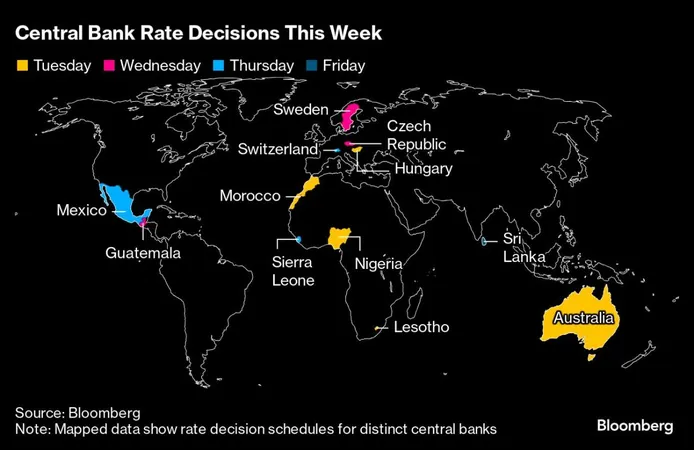
The Fed's Anticipated Jumbo Rate Cut: A New Economic Validation?
2024-09-22
Author: Yan
The Federal Reserve's Bold Move
The Federal Reserve is poised to receive validation for its bold interest rate cut, as key economic indicators are expected to support both the central bank's decision and Chair Jerome Powell's assertion that the economy remains robust.
Inflation Trends and Rate Cuts
Economists predict that the personal consumption expenditures (PCE) price index will see a modest rise of just 0.1% in August—marking only the second such occurrence in three months. Year-over-year inflation is estimated to be at a mere 2.3%, the smallest increase since early 2021, which is slightly above the Fed's target of 2%. This slowdown in inflation can be attributed to reductions in energy and food prices as well as a decline in core cost pressures.
Confidence in Policy Implementation
This drop in inflation gave Fed policymakers enough confidence to implement a significant rate cut on September 18, reducing rates by half a percentage point—the first cut in over four years. This move signifies a strategic pivot aimed at protecting the job market from potential downturns.
Upcoming Economic Insights
As we look ahead, a slew of remarks from various Fed officials will likely illuminate their stance on future economic conditions. Prominent figures such as Governors Michelle Bowman, Adriana Kugler, and Lisa Cook are expected to speak at different events, providing insights into the central bank’s outlook.
Consumer Spending and Economic Growth
In addition to inflation figures, the upcoming report will include data on personal spending and income, which economists anticipate will show robust growth in household expenditures. Continuous consumer spending is vital, as it bolsters the prospect of ongoing economic expansion.
Additional Economic Data
Additional economic data on the horizon comprises new home sales for August and updates on the gross domestic product (GDP), which includes revisions spanning back to 2019. Weekly jobless claims and orders for durable goods will also be closely monitored.
Soft Landing Possibilities
Economists from Bloomberg Economics highlight that while the recent rate cut increases the probability of achieving a "soft landing" for the economy, it does not guarantee one. Their outlook suggests that the unemployment rate may rise to 4.5% by the end of 2024 before reaching 5% next year.
Global Economic Context
On an international scale, economic developments are unfolding in Canada, where GDP data for July and preliminary estimates for August are projected to indicate sluggish growth, likely below the Bank of Canada’s expectation of a 2.8% annualized increase. Additionally, continued discussions regarding monetary policy adjustments are taking place among several central banks globally.
Central Banks Scrutinizing Rates
In Australia, the Reserve Bank is expected to maintain its current rate at 4.35% during its upcoming meeting, with scrutiny on Governor Michele Bullock's tone following positive labor statistics. Meanwhile, inflation updates from Malaysia, Singapore, and Japan are set to be released, while purchasing manager indexes from various countries will provide insight into private sector activity.
European Central Banks' Dilemma
Across Europe, central banks are grappling with whether to adopt similar aggressive rate cuts as the Fed. The Swiss National Bank, for instance, is expected to consider a quarter-point reduction, while developments in other nations including Hungary and the Czech Republic will unfold later this week.
Conclusion: A Shifting Economic Landscape
The global economic landscape is rapidly evolving, presenting challenges and opportunities for investors and policymakers alike. As central banks navigate their strategies amid shifting economic metrics, the understanding of their implications will be crucial for future market developments. Stay tuned as we continue to cover the unfolding economic scenarios in various regions and provide insights into how these changes may affect global markets.




 Brasil (PT)
Brasil (PT)
 Canada (EN)
Canada (EN)
 Chile (ES)
Chile (ES)
 Česko (CS)
Česko (CS)
 대한민국 (KO)
대한민국 (KO)
 España (ES)
España (ES)
 France (FR)
France (FR)
 Hong Kong (EN)
Hong Kong (EN)
 Italia (IT)
Italia (IT)
 日本 (JA)
日本 (JA)
 Magyarország (HU)
Magyarország (HU)
 Norge (NO)
Norge (NO)
 Polska (PL)
Polska (PL)
 Schweiz (DE)
Schweiz (DE)
 Singapore (EN)
Singapore (EN)
 Sverige (SV)
Sverige (SV)
 Suomi (FI)
Suomi (FI)
 Türkiye (TR)
Türkiye (TR)
 الإمارات العربية المتحدة (AR)
الإمارات العربية المتحدة (AR)